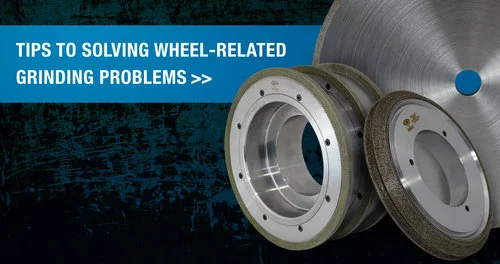Tips To Solving Wheel-Related Grinding Problems
Grinding problems show up in two ways: in the appearance of the workpiece and as cost or productivity issues. After verifying that the grinding machine isn’t at fault, attention should turn to the grinding wheel.
Appearance problems divide into poor surface finish, chatter, and burning. Cost and productivity issues are short wheel life, slow cutting, and the wheel not cutting.
APPEARANCE ISSUES
Poor finish
Grinding is a multi-point cutting process, but down at the microscopic level it’s little different to a single point operation like turning. Viewed this way, it’s easy to see how surface finish is affected by the same factors: the more material removed by each grinding point, bigger the individual chips and the rougher the surface.
The solutions are:
Select a finer grit size
Reduce the relative speed of wheel and workpiece
If grinding wet, it might also be that the coolant is not removing chips from the workpiece/wheel interface. It's also possible that the wheel is being dressed excessively, creating grinding points standing too proud of the wheel surface.
Chatter
Recognizable by a distinct pattern on the workpiece, and often audible, chatter has many causes. If initiated by a vibration in the machine – possibly some kind of resonance – the solution is to vary the grinding speed. Try going 10% faster or slower to remove the forcing excitation.
Wheel-induced chatter occurs when an out-of-true grinding wheel acts as an excitation source. In this case the wheel should be trued carefully. Also check it isn’t slipping on its mount. A detailed discussion of chatter is available at the Abrasive Engineering Society website.
Burning
Machinists use this term to mean thermal damage. It can range from cosmetic discoloration to changes in workpiece hardness and possibly the creation of distortion-inducing internal tensile stresses. Burning is far more common when grinding dry, although can still be experienced in wet grinding if there isn't enough coolant flow to carry away the heat. “Burn Awareness”, originally published in Cutting Tool Engineering, December 2000, provides more information.
Burning can occur if the wheel is glazed or loaded, so there is more rubbing and hence more friction, by trying to push the wheel through the workpiece too quickly, or by using a wheel that’s too durable.
Solutions are:
Dress the wheel with a dressing stick
Reduce the feed rate or the relative velocity between wheel and workpiece.
COST AND PRODUCTIVITY ISSUES
Wheel life too short
This can be caused by:
Insufficient coolant
Dressing too often
A wheel that's either too hard or too soft for the workpiece (so it loads up or wears away too quickly)
Wheel speed too low
Slow cutting
Usually caused by feeds and/or wheel speeds that are too low, the solution is to grind as fast as possible without burning.
Wheel not cutting
This happens when the wheel is glazed by truing. The solution is to dress the wheel lightly until the grit opens up.
THINK LOGICALLY
Most grinding problems can be solved by relating the fault back to basic principles. Picture material being removed by individual cutting points and a solution usually emerges.

